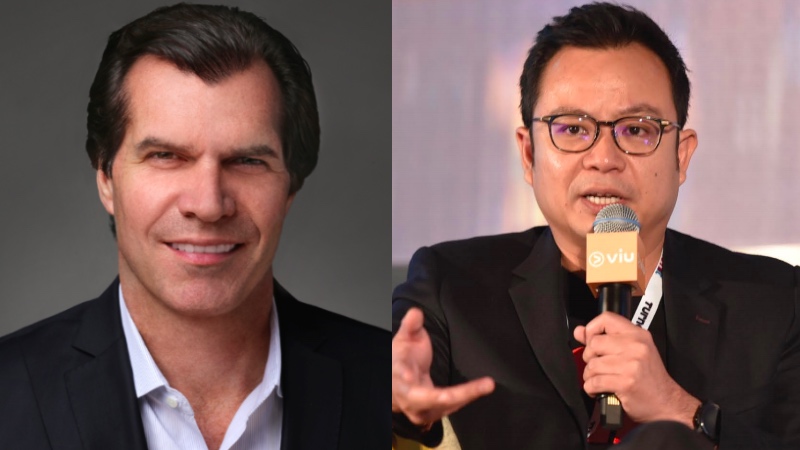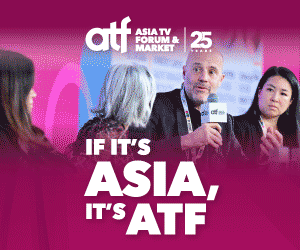
By Janine Stein
Oi! Jaga Mulut host Haniff Hamzah makes one promise in the first few seconds of iflix’s Oi! Jaga Mulut: the show, he says, is where “comedians have been told not to give a shit about what people say about them, let loose, say what you want to say, hehe, I love this show”. Sure he does. Luckily, so does Mark Francis, the guy who let him run with the first Asian original out of iflix’s fledgling original production division.
Francis, as global director of original programming, says he was confident the stand-up comedy format was the right way to go. But he didn’t think it would rise to number two in Malaysia in its first week, second only to Korean drama The Bride of Habaek.
“If you would have told me that would happen, I would have said ‘get out of here’,” Francis says. He couldn’t kick modesty out of the way fast enough, ditching the original plan to stream one episode a week and scrambling to upload everything immediately.
The ability to pivot on a dime, to change direction mid-stream, is a proud iflix characteristic. “We call it being agile,” CEO Mark Britt told me when I asked him once whether he often upended set plans.
Turns out, much as he embraced the Oi! Jaga Mulut release pivot, the ‘dime’ part of the idiom occupies a more significant part of Francis’ days and nights at iflix.
“How much money do you really have?” I ask, amid rumours (unconfirmed) that he has US$20 million, maybe US$30 million, to spend. “I have in the millions for year one,” he says, emphasising that this is “more than I’ve ever had in my career of working with regional networks in the past”.
There are other ways he’s leaving the past well behind, starting with not engaging in price-per-hour discussions; “If I told you US$100,000 per episode, what does that even mean?”.
“I’m so tired of having conversations with producers who come up with great ideas, and I ask, ‘what does it cost to execute this treatment?’, and they say ‘what do you have to make it with and I’ll do it’.
That’s not the way I want to work,” he says. “I would rather have real conversations about money”. Put it this way: “I have the money to make the creative differentiation and impact that I want”.
So how might a discussion with a producer go, bearing in mind that a big part of the job is to be financially responsible? In addition to the commercial imperative to challenge the status quo, “I’m looking at what things cost versus your vision for the show”.
He’s running, of course, with what’s working. Versions of Oi! Jaga Mulut have been made for Indonesia (Oi! Jaga Lamba, which premieres in December 2017 or January 2018) and the Philippines (Hoy! Bibig Mo, which premieres on 1 December). An English-language one-hour comedy special is being planned for January 2018. Francis hopes to use this special as “a modest charity drive, with the long-term ambition of building our ...
By Janine Stein
Oi! Jaga Mulut host Haniff Hamzah makes one promise in the first few seconds of iflix’s Oi! Jaga Mulut: the show, he says, is where “comedians have been told not to give a shit about what people say about them, let loose, say what you want to say, hehe, I love this show”. Sure he does. Luckily, so does Mark Francis, the guy who let him run with the first Asian original out of iflix’s fledgling original production division.
Francis, as global director of original programming, says he was confident the stand-up comedy format was the right way to go. But he didn’t think it would rise to number two in Malaysia in its first week, second only to Korean drama The Bride of Habaek.
“If you would have told me that would happen, I would have said ‘get out of here’,” Francis says. He couldn’t kick modesty out of the way fast enough, ditching the original plan to stream one episode a week and scrambling to upload everything immediately.
The ability to pivot on a dime, to change direction mid-stream, is a proud iflix characteristic. “We call it being agile,” CEO Mark Britt told me when I asked him once whether he often upended set plans.
Turns out, much as he embraced the Oi! Jaga Mulut release pivot, the ‘dime’ part of the idiom occupies a more significant part of Francis’ days and nights at iflix.
“How much money do you really have?” I ask, amid rumours (unconfirmed) that he has US$20 million, maybe US$30 million, to spend. “I have in the millions for year one,” he says, emphasising that this is “more than I’ve ever had in my career of working with regional networks in the past”.
There are other ways he’s leaving the past well behind, starting with not engaging in price-per-hour discussions; “If I told you US$100,000 per episode, what does that even mean?”.
“I’m so tired of having conversations with producers who come up with great ideas, and I ask, ‘what does it cost to execute this treatment?’, and they say ‘what do you have to make it with and I’ll do it’.
That’s not the way I want to work,” he says. “I would rather have real conversations about money”. Put it this way: “I have the money to make the creative differentiation and impact that I want”.
So how might a discussion with a producer go, bearing in mind that a big part of the job is to be financially responsible? In addition to the commercial imperative to challenge the status quo, “I’m looking at what things cost versus your vision for the show”.
He’s running, of course, with what’s working. Versions of Oi! Jaga Mulut have been made for Indonesia (Oi! Jaga Lamba, which premieres in December 2017 or January 2018) and the Philippines (Hoy! Bibig Mo, which premieres on 1 December). An English-language one-hour comedy special is being planned for January 2018. Francis hopes to use this special as “a modest charity drive, with the long-term ambition of building our own ‘comic relief’.”
The comedy shows are part of an original production slate that embraces local producers and production houses in emerging markets and starts testing the waters for a new category of programming – hyper-local, carefully thought through, nicely produced on budgets
appropriate for emerging markets that may – but doesn’t have to – find audiences in other emerging markets.
When he joined iflix in May 2016 to drive original production, Francis’ first decision was to create “cutting edge stuff that we hope will travel but we aren’t going to try to contrive it for a pan-regional position”.
Francis entered a market with a quality gulf between tentpole independent local movies versus the “large volume of frankly pretty shit sausage factory local TV drama”. He didn’t want to do anything like that. “And we didn’t have to, because we’re not a channel. I don’t have to strip and I don’t have to win Sunday nights,” he says.
The decision to go for impact over volume was made early. “I wasn’t out there to commission 60 or 120 episodes of a drama or use the processes that seem to be endemic in local TV drama and are, in my opinion, pretty bad habits, like writing scripts on Monday and shooting on Wednesday”.
He also didn’t come to the table with too little money (as we’ve already determined even if we don’t know how much) to do things differently. “There’s almost no genre in local drama in Southeast Asia. And that’s because you only have enough budget to sit in a room and shoot people, to have a dialogue indoors. Well, guess what, when you do that you get soap opera or some version of it,” he says.
“I was far more interested in what’s going on in the movie space, in talking to people with authentic voices and creators with a vision who are making movies under really challenging circumstances and doing them fairly well.
“My view is that if I can get some of the movie guys to look at spin-offs, reboots or sequels of some of the films, or fresh ideas, and do them in six or eight parts at a budget level that allows us to do action, horror, thriller, fantasy, then why the hell not?”
The originals’ strategy has multiple layers, including publicity/marketing value. “There is a limit to what we can do when we acquire content, whether big Korean or American. We are hardly going to get the cast in market very often. The originals enable us to create more touch points for consumers... allow us to be much more connected to the community of viewers and followers,” Francis says.
Differentiation is a big deal, and frankly, he says, “it’s not that hard because there’s so much that simply hasn’t been done in the local space”.
But he isn’t into raging departures from what went before. He calls it the “same same but different” strategy. iflix content is a bit more edgy, perhaps challenges censorship boundaries a bit more than people are used to, or focuses on under-developed formats, cast or directors.
“But I didn’t want to go too far off the reservation,” he adds. “I think that difference needs to be calibrated and we need time for the audience to follow... I needed to find that sweet spot that is clearly differentiated in some shape or form but not so alien from a content marketing perspective that I can’t get very far introducing that new idea.”
“Ultimately the ambition is to fundamentally lift the bar in production value”, beginning with originals for iflix’s big three markets in Southeast Asia – Philippines, Indonesia and Malaysia.
The slate so far includes a feature film starring Philippines’ actress Kris Aquino scheduled for release in the first half of 2018, and an eight-part Indonesian drama series, Magic Hour, which was announced in April 2017.
Created by one of Indonesia’s Screenplay Films, Magic Hour the series is a spin-off of the 2015 teen romance movie, which was Indonesia’s fifth highest grossing film that year. The movies two leads – Dimas Anggara and Michelle Zudin – return for the series.
There’s also KL Gangster: Underworld, a hard-hitting six-party crime drama based on Malaysia’s iconic movie The Gangster, scheduled for release in mid-2018. KL Gangster: Underworld is co-directed by Syafiq Yusof (Abang Long Fadil 2) and Faisal Ishak (Juvana). Other dramas are in development.
iflix is also boosting its factual footprint, commissioning six-part news and culture magazine show, Coconuts TV on iflix, from Byron Perry’s Coconuts Media. The series is currently in post-production.
The originals are part of widespread change and broad expansion at the two-year-old streaming platform in the past year, and slot into an interface and user experience that is very different from the platform iflix debuted in 2015.
iflix also spent this year raising more than US$220 million in new funding, connecting with traditional rights holders, rolling out its new interface, seeing off key execs and welcoming replacements and launching in five new territories – Pakistan (January), Vietnam (February), Myanmar (March), Cambodia (August) and Nepal (October). This brings distribution to a total of 24 markets in Asia, Africa and the Middle East.
Chief content officer Sean Carey describes the new interface, launched in September this year, as a radical departure from rows and rows of box art. The new order, Carey adds, is “channels re-imagined around genres, brands and people”.
The shift into channels is iflix’s nod to the branded destination space that television audiences are familiar with, but layered with the choices enabled by digital technology. Some of iflix’s channels, such as Oh!K and tvn Movies, exist in the linear/traditional environment as linear services. Others – ABC on demand, Pixar and Marvel – have been curated for iflix.
The reasoning is not complicated. Carey says the new platform enables the discovery of content that wasn’t being surfaced properly or sufficiently before.
“One of the things I have learned is to put the consumer first and let that drive how you think about interfaces and content. What we discovered is that people weren’t going deep down into the user experience to discover a lot of the great content that we had,” he says.
That goes for Western, regional and local content.
“Presenting all that with brands that consumers recognise front and centre enabled us to surface the content in a much deeper way,” Carey says.
For all its focus on emerging markets, iflix is doing more than a little emerging of its own, mostly away from the perception that it’s a low-cost version of Netflix for people who can’t afford a global platform with global pricing.
iflix is the “flip side of the coin” from Netflix, Carey, who worked for Netflix from 2011 to 2016, says.
Emerging markets, he adds, have a “radically different consumer” from those being addressed by Netflix and Amazon. Not only is sachet pricing built into the way they look at the world, they are also mobile first. “In many cases they have disposable income for the first time and have a device in their hands and not in their living rooms,” Carey says.
The emerging focus on hyper-local originals lives alongside the ongoing commitment to licensed content across multiple genres, including kids’ titles such as Malaysia’s Upin & Ipin, Barney and Friends, Ben 10 and Disney’s Frozen, The Little Mermaid and Big Hero 6, and the first six instalments of Star Wars.
“Licensed content will always play an important role. We aren’t going to be 100% original any time soon. That isn’t the goal,” Carey says. On the contrary.
Talking about experimenting with non-English-language acquisitions, Carey says a characteristic of the iflix footprint is that rights are often not valued the same way across Africa and the Middle East. “Adding African rights to Asian content is fairly inexpensive and easy to do and we believe we will find an audience for that content and vice versa,” he says.
Along with the experimentation are regular reminders of where local audiences’ hearts are.
When iflix launched in Myanmar in March, “we were excited to bring international content to the territory for the first time in any meaningful degree,” Carey says. Local audiences didn’t turn out to be quite as excited. “The substantial majority of viewing is on local content. It’s interesting to see how deeply that consumer behaviour is ingrained across our footprint.”
He adds that the triggers for the dawning golden age of television in emerging markets are very likely going to be the same as in the U.S. – free/basic/premium television channels and online services investing heavily in differentiating themselves with, primarily, scripted television.
“I don’t think it’s far fetched to see a scenario playing out in emerging markets, where pay platforms will invest in original content, free-to-air broadcasters up their game to continue to maintain audience, and then the real flash point will be online services like iflix, which will invest deeply to try to build audience in a hyper-local way,” Carey says. It’s already happening.
What’s next? At the moment, discussion and testing with, among other genres such as kids and factual, sports. We have started testing our way into this, with, for instance, sports like the McGregor Mayweather fight, which iflix streamed live in Indonesia. Or the alternative news show commissioned from Coconuts TV.
“I think the platform that we have created enables us to have those kinds of discussions and potentially take the service in those directions.”
He’s not saying yes – or no – to linear streaming on iflix in the same way as, for instance, tonton in Malaysia. “For certain types of content linear plays a role. As a general statement though, most consumers will watch most content on demand”.



















